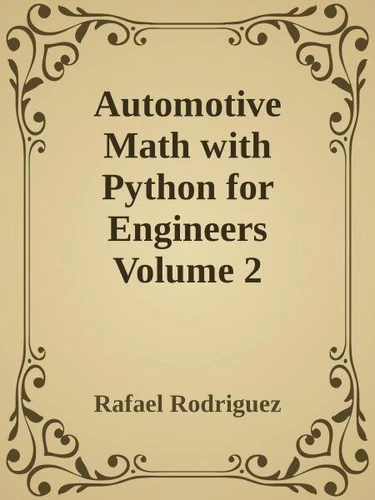Automotive Math with Python for Engineers Volume 2. 2, #2
Par :Formats :
Disponible dans votre compte client Decitre ou Furet du Nord dès validation de votre commande. Le format ePub est :
- Compatible avec une lecture sur My Vivlio (smartphone, tablette, ordinateur)
- Compatible avec une lecture sur liseuses Vivlio
- Pour les liseuses autres que Vivlio, vous devez utiliser le logiciel Adobe Digital Edition. Non compatible avec la lecture sur les liseuses Kindle, Remarkable et Sony
 , qui est-ce ?
, qui est-ce ?Notre partenaire de plateforme de lecture numérique où vous retrouverez l'ensemble de vos ebooks gratuitement
Pour en savoir plus sur nos ebooks, consultez notre aide en ligne ici
- FormatePub
- ISBN8224691814
- EAN9798224691814
- Date de parution04/09/2024
- Protection num.pas de protection
- Infos supplémentairesepub
- ÉditeurVirtued Press
Résumé
Automotive Math with Python for Engineers Volume 2 takes a deep dive into advanced automotive engineering concepts like Finite Element Method (FEM), nonlinear dynamics, fracture mechanics, and machine learning applications in automotive design. This volume builds on the foundational principles introduced in the first volume, providing detailed theoretical explanations paired with practical Python implementations.
Engineers, researchers, and advanced students will benefit from this resource, which addresses complex topics like optimization of vehicle systems, multiphysics simulations, and analysis of nonlinear material behaviors, helping readers apply these advanced techniques to real-world automotive challenges.
Engineers, researchers, and advanced students will benefit from this resource, which addresses complex topics like optimization of vehicle systems, multiphysics simulations, and analysis of nonlinear material behaviors, helping readers apply these advanced techniques to real-world automotive challenges.
Automotive Math with Python for Engineers Volume 2 takes a deep dive into advanced automotive engineering concepts like Finite Element Method (FEM), nonlinear dynamics, fracture mechanics, and machine learning applications in automotive design. This volume builds on the foundational principles introduced in the first volume, providing detailed theoretical explanations paired with practical Python implementations.
Engineers, researchers, and advanced students will benefit from this resource, which addresses complex topics like optimization of vehicle systems, multiphysics simulations, and analysis of nonlinear material behaviors, helping readers apply these advanced techniques to real-world automotive challenges.
Engineers, researchers, and advanced students will benefit from this resource, which addresses complex topics like optimization of vehicle systems, multiphysics simulations, and analysis of nonlinear material behaviors, helping readers apply these advanced techniques to real-world automotive challenges.







